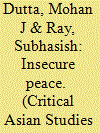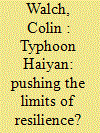| Srl | Item |
| 1 |
ID:
157940


|
|
|
|
|
| Summary/Abstract |
This paper examines emerging citizen and local government relations in a village in the Junglemahal region of the state of West Bengal, once a major bastion of the Maoist insurgency in India. Since 2014, Junglemahal has not experienced a single Maoist-related incident. This has been widely attributed to the West Bengal government’s “model” handling of the insurgency, which rests on the rapid mobilization of public services through the non-elected arms of local governments, bypassing elected officials. How have Junglemahal’s residents experienced this particular form of post-conflict governance? Drawing on the culture-centered approach that ethnographically observes the processes of identifying development problems and developing community-grounded solutions to these problems, our findings indicate that the hyper-developmental state was paradoxically experienced by our respondents as a very distant entity. A recurrent theme in our interviews is the absence of a locally embedded party leadership that could be approached regarding issues of distributive justice. We argue that this desire for party mediation in public service delivery is an expression of a powerful social norm that has survived the conflict and ought to be integrated into post-conflict governance structures if the current peace is to endure.
|
|
|
|
|
|
|
|
|
|
|
|
|
|
|
|
| 2 |
ID:
157945


|
|
|
|
|
| Summary/Abstract |
Disaster risk reduction has been an important priority in the Philippines for the last twenty years. Yet Typhoon Haiyan still resulted in at least 6000 deaths and affected more than 14 million people. Why was this the case in a country supposedly well equipped to respond to natural disasters? While there are several explanations, including the sheer scale of this typhoon, corruption, and implementation challenges, this paper focuses on growing social and economic inequalities. This paper argues that the resilience discourse and framework at the national level do not translate into programs that help lift people out of poverty, particularly landless people. This is because state-led resilience policies focus on technical aspects of recovery rather than the root cause of vulnerabilities, explaining to some extent the high level of casualties in the wake of typhoon Haiyan. Evidence supporting this argument is drawn from more than forty interviews between 2013 and 2015 with disaster victims and professionals involved in resilience building.
|
|
|
|
|
|
|
|
|
|
|
|
|
|
|
|